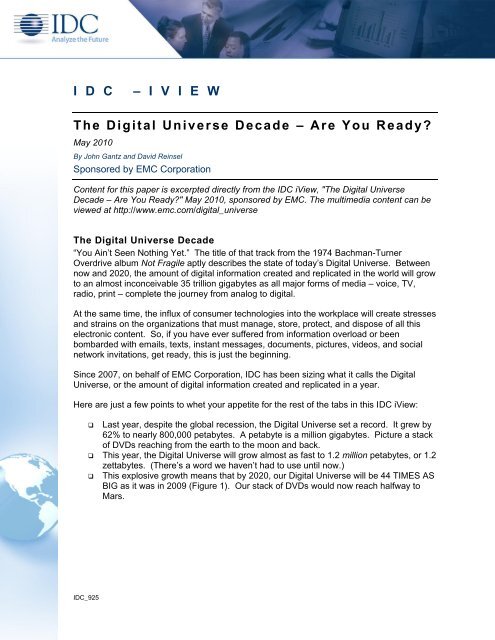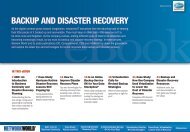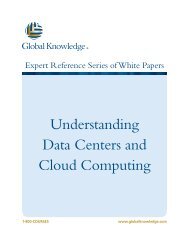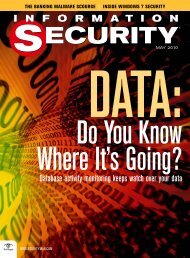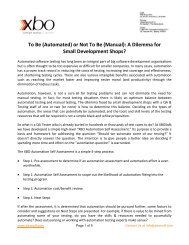A Digital Universe Decade, Are You Ready? - EMC
A Digital Universe Decade, Are You Ready? - EMC
A Digital Universe Decade, Are You Ready? - EMC
- No tags were found...
Create successful ePaper yourself
Turn your PDF publications into a flip-book with our unique Google optimized e-Paper software.
Here’s another question for you. What comes after a quadrillion? That’s right, a quintillion,an incomprehensible number, yet the one you need to describe the number of informationcontainers – packets, files, images, records, signals – that the bits in the <strong>Digital</strong> <strong>Universe</strong> willbe in by 2020. There will be 25 quintillion containers.These containers, the files if you will, are the things that are actually managed, protected,and stored in the <strong>Digital</strong> <strong>Universe</strong>.And, because of the growth of embedded systems in the smart grid, smart cities, logisticitem tracking, and so on, the average file size in the universe is getting smaller. The numberof things to be managed is growing twice as fast as the total number of gigabytes. Goodluck, all you CIOs out there.Think of the growth of the <strong>Digital</strong> <strong>Universe</strong> as a perpetual tsunami. As this universe growsby an order of magnitude, we will have to deal with information in new ways:How will we find the information we need when we need it? We will need newsearch and discovery tools. Most of the <strong>Digital</strong> <strong>Universe</strong> is unstructured data (forexample, images and voice packets). We will need new ways to add structure tounstructured data, to look INSIDE the information containers and recognize contentsuch as a face in a security video. In fact, the fastest-growing category in the <strong>Digital</strong><strong>Universe</strong> is metadata, or data about data.How will we know what information we need to keep, and how will we keep it? Yes,we will need new technical solutions tied to storage, but we will surely also need newways to manage our information. We’ll need to classify it by importance, know whento delete it, and predict which information we will need in a hurry.2©2010 IDC
How will we follow the growing number of government and industry rules aboutretaining records, tracking transactions, and ensuring information privacy?Compliance with regulations has become an entire industry – a $46 billion industrylast year – but will it be enough?How will we protect the information we need to protect? If the amount of informationin the <strong>Digital</strong> <strong>Universe</strong> is growing at 50% a year or so, the subset of information thatneeds to be secured is growing almost twice as fast. The amount ofUNPROTECTED yet sensitive data is growing even faster.As we contemplate the growth of the <strong>Digital</strong> <strong>Universe</strong>, these are some of the things we needto think about:‣ New search tools‣ Ways to add structure to unstructured data‣ New storage and information management techniques‣ More compliance tools‣ Better securityThere are plenty of others, including the role of cloud computing, the consumerization of theworkplace, the growing share of the <strong>Digital</strong> <strong>Universe</strong> coming from China and India, and thegrowing diversity – in content type and container type – of the <strong>Digital</strong> <strong>Universe</strong>.Here is another statistic to keep in mind before you start reviewing our other findings:Although the amount of information in the <strong>Digital</strong> <strong>Universe</strong> will grow by a factor of 44, andthe number of containers or files will grow by a factor of 67 from 2009 to 2020, the numberof IT professionals in the world will grow only by a factor of 1.4.Big changes are coming.Information in the CloudsBy 2020, a significant portion of the <strong>Digital</strong> <strong>Universe</strong> will be centrally hosted, managed, orstored in public or private repositories that today we call “cloud services.” And even if a bytein the <strong>Digital</strong> <strong>Universe</strong> does not “live in the cloud” permanently, it will, in all likelihood, passthrough the cloud at some point in its life.There are almost as many definitions of cloud services as there are vendors trying to gainadvantage by offering them. But in the IDC definition, they require availability over anetwork, consumption on-demand with pay-as-you-go billing, and some level of user controland system openness that separates cloud services from simple online delivery of content.It’s software as a service, not downloading software programs. It’s watching on-demandInternet TV, not merely downloading Netflix videos.At the same time, cloud services can be offered as a shared common functionality (publiccloud) or as a private version (private cloud), where an organization maintains completecontrol of all of the IT resources and how they are managed and secured. The latter caneven be offered within the enterprise itself.Although IDC has only sized the market for IT functionality – hardware, software, services –delivered over the public cloud at this point, a look at the makeup of the <strong>Digital</strong> <strong>Universe</strong> bycontent type – entertainment, financial transaction, medical information, and user-generated©2010 IDC 3
image content – gives one a feel for how big cloud services in other industries couldbecome in the <strong>Digital</strong> <strong>Universe</strong>.Using reasonable forecast assumptions such as those in the IDC forecast for IT cloudservices, it is possible to conclude that as much as 15% of the information in the <strong>Digital</strong><strong>Universe</strong> in 2020 could be part of a cloud service – created in the cloud, delivered to thecloud, stored and manipulated in the cloud, etc. Even more information could “pass throughthe cloud,” that is, be transported using a cloud services email system or shared community,be stored temporarily on disk drives in the cloud, be secured via a cloud service, etc. By2020, more than a third of all the information in the <strong>Digital</strong> <strong>Universe</strong> will either live in or passthrough the cloud (Figure 2).Because so much of the content in the <strong>Digital</strong> <strong>Universe</strong> is in the form of images – fromdigital TV to user-generated images – nearly 50% of the <strong>Digital</strong> <strong>Universe</strong> cloud-basedsubset will be tied to entertainment.But every industry will have some form of cloud-based services to offer. And with theseservices come unique challenges and benefits:The promise of cloud services, besides lower upfront investment, is ease ofmanagement. But as users of IM systems in the early days and users of iTunestoday realize, conversion from one service to another is not always seamless.Cloud services imply access to broadband services, which are not always available.Perhaps more challenging is the fact that cloud services may spur more need forbandwidth. Already, telco carriers are complaining that users of smart phones are4©2010 IDC
using much more bandwidth than predicted as they rush to use more and moreapplications.Overall, security may actually be enhanced in the cloud – as cloud providers buildsecurity and transparency into the cloud infrastructure from the get-go. But theimpact of a failure, should there be one, could be significant. This could be aproblem in private clouds as well as public clouds. And with the loss of physicalcontrol over infrastructure, ensuring visibility in the cloud will be critical fordemonstrating compliance.Even with information stored or manipulated in the cloud, enterprises still have responsibilityand liability over it. Managing this from afar might be a challenge.But the benefits of cloud services will be substantial. Using IDC’s current forecast for ITcloud services and assuming that the use of cloud services could lower the portion of the ITbudget devoted to legacy system maintenance by a fraction of a percent, we estimate thatthe increase in IT dollars spent on innovation could drive more than $1 trillion in increasedbusiness revenues between now and the end of 2014.Protected and Unprotected DataDo you know where your social security number is?Think about it. <strong>You</strong> probably have to enter it onto forms 10 times a year, maybe 50. Fromthere it enters the <strong>Digital</strong> <strong>Universe</strong>, living in all sorts of databases, from those in yourdoctor’s office and tax accountant’s office, to bank records, company personnel records,mortgage records, and so on. It shuttles around from database to database at the speed oflight. It gets backed up again and again.In fact, those 10 entries (counting the entries into linked or associated files, accessed bypeople allowed to access the databases with your number in it, and the backups) could bepropagated as many as a million times in a year!How secure are those entries?By 2020, almost 50% of the information in the <strong>Digital</strong> <strong>Universe</strong> will require a level of ITbasedsecurity beyond a baseline level of virus protection and physical protection. That’s upfrom about 30% this year. And while the portion of that part of the <strong>Digital</strong> <strong>Universe</strong> thatneeds the highest level of security is small – in gigabytes and total files – that portion willgrow by a factor of 100.Not all data needs to be protected equally. A <strong>You</strong>Tube video of a cat doing tricks wouldseem to need less protection against hacking or corruption than a home-banking customer’saccount balances. But each <strong>You</strong>Tube video is associated with an IP address and end-userprofile, and of course, that video might not be of a cat but of something not fit for publicviewing. Even worse, that seemingly innocuous cat video may actually be an effectivedelivery mechanism for the new variants of malware being created by the criminalunderground.©2010 IDC 5
For the sake of understanding the degree of security in the <strong>Digital</strong> <strong>Universe</strong>, we haveclassified information that requires security into five successively higher security-levelcategories:Privacy only – such as an email address on a <strong>You</strong>Tube uploadCompliance-driven – such as emails that might be discoverable in litigation or besubject to retention rulesCustodial data – account information, a breach of which could lead to or aid inidentity theftConfidential data – information the originator wants to protect, such as trade secrets,customer lists, or confidential memosLockdown data – information requiring the highest security, such as financialtransactions, personnel files, medical records, or military intelligenceObviously, information can switch categories over its life, or, in aggregation, gain more valueover time and hence need higher security. The information that you visited a single websitemight be less sensitive than your entire web-browsing history, or even less sensitive thanthe information about how many times you visited the website.By examining information by category and source, it’s possible to estimate the amount ofinformation in the <strong>Digital</strong> <strong>Universe</strong> that needs some level of security. That which doesn’t ismostly transient data, especially digital TV signals and voice packets that aren’t neededafter a broadcast or call is over (Figure 3).However, just because the information should have protection doesn’t mean that it does.Using the same process of categorization, it is possible to estimate the amount ofinformation that is not adequately protected.6©2010 IDC
<strong>Digital</strong> <strong>Universe</strong>. The other 90% is composed of credit records, surveillance photos,analytics on behavior, web-use histories, and so on.Probably EVERY byte in the <strong>Digital</strong> <strong>Universe</strong> could use some security and privacyprotection. But we will never know because we can never know exactly what all those filesand gigabytes actually contain.The Future of <strong>Digital</strong> Information StorageIn the inaugural <strong>Digital</strong> <strong>Universe</strong> study, IDC forecasted that by 2007, for the first time, theamount of digital information created would exceed the amount of available storage. Thatinflection point has since become a gulf that continues to expand. Every year, the industryships thousands of petabytes of new storage capacity, including hard disk drives, optical,tape, nonvolatile memory (flash), and volatile memory (DRAM). The total amount of storagecapacity available is equal to all new shipments of storage plus all unused storage fromprevious years. While previously consumed storage could be overwritten, IDC assumes thiscapacity is reserved for what is already stored on the storage medium.Hence, we have a growing gap between the amount of digital content being created and theamount of available digital storage. IDC estimates that in 2009, if people had wanted tostore every gigabyte of digital content created, they would have had a shortfall of around35%. This gap is expected to grow to more than 60% (that is, more than 60% of thepetabytes created could not be stored) over the next several years (Figure 5).While much of the digital content we create is simply not that important (not much differentfrom the paper magazines and newspapers that we throw away, or the telephoneconversations, receipts, bad pictures, etc., that we never save), the amount of data thatdoes require permanent or longer-term preservation for a multitude of reasons is increasingexponentially.8©2010 IDC
But as we peer into the future, we see the greatest challenges are related not to how tostore the information we want to keep, but rather to:Reducing the cost to store all of this contentReducing the risk (and even greater cost) of losing all of this contentExtracting all of the value out of the content that we saveIDC data shows that nearly 75% of our digital world is a copy – in other words, only 25% isunique. Granted, various laws and regulations require multiple copies exist in order toensure the availability of data over a long period of time. Multiple copies of data are alsonecessary to ensure proper performance by applications, or to protect data in the event ofhardware failures. Nevertheless, the amount of data redundancy is excessive in manycases, and it represents a prime area for improvement and cost reduction.Most of today’s de-duplication happens on 2 nd tier storage, but it doesn’t have to.Tomorrow’s opportunity is for de-duplication on primary storage (assuming no impact toperformance), which would significantly reduce or eliminate post-process de-duplication.The cloud is an especially attractive place to eliminate redundancy, given its one-to-manymodel of content aggregation.IDC’s forecast portends a huge amount of consumer-attached storage, either directly tohosts or via a network. The external drive market will continue to experience considerablegrowth. Hence, there is a growing need to enable storage management by consumers. Ascomputing races down the mobility path, one person may find himself with multiplecomputing devices (each potentially with its own operating system), and various amounts oflocal storage, all of them providing similar ways to access the cloud (via wireless cellular orwireless broadband).Sharing the same content among these devices will increase in importance. The cloud mustplay a strategic role in becoming the central axis for all of this content – yet there is muchwork to do in order to make this happen. Until then, individuals will strive to keeppasswords, content, and services mapped appropriately among their digital device portfolio.Personalized services (e.g., GPS, proactive coupon pushing, e-commerce) will grow inimportance as more data about one’s personal habits and preferences is captured andmined by sophisticated applications. Granted, many people today may find this to beintrusive or a direct violation of their personal privacy. But as newer generations of teensand adults use their beloved digital devices, various types of data will be captured andleveraged to deliver services that not only will be embraced, but also will be considered oneof those can’t-get-along-without-it technologies. The personal data captured and used todeliver these services must be tied to an individual anonymously, and it must be managed inaccordance with strict governance and compliance procedures in order to ensure thatprivacy is not breached. This is, as they say, “easier said than done.” Nevertheless, it mustbe done.Personal privacy is paramount, and although there are behaviors one can employ to lessenone’s digital footprint, no one can completely disappear off the ubiquitous digital grid. Videosurveillance and purchasing transactions will be nearly impossible to avoid, and interactionin social networks will be either commonplace or a temptation that is difficult to overcome.©2010 IDC 9
In the end, corporations and consumers will continue to create, copy, and store information– mostly on traditional storage technologies such as hard disk drives. Much of the data thatis created will be disposable or a means to a final copy – hence the growing gap betweencontent creation and available storage. However, the content that is stored will be deemedimportant and vital for evolving our businesses and business models, for extending ourdigital presence (that should result in more convenience and personalization), and perhapsmost important, for protecting our digital heirlooms.Consumers Without BordersWhen you think of the <strong>Digital</strong> <strong>Universe</strong>, you may think of the financial databases of WallStreet, the acres of servers operating at giant Internet service providers, or the storagedevices supporting 100 million enterprises in the world.But, in fact, most of the <strong>Digital</strong> <strong>Universe</strong> begins with an action by a consumer – an emailtyped on a laptop, a digital photo taken at a wedding, a movie downloaded from Netflix.In fact, more than 70% of the <strong>Digital</strong> <strong>Universe</strong> this year will be generated by users –individuals at home, at work, and on the go. That’s 880 billion gigabytes.At the same time, most of the gigabytes in the <strong>Digital</strong> <strong>Universe</strong> pass through the servers,network, or routers of an enterprise at some point. When they do, the enterprise isresponsible at that moment for managing that content, protecting user privacy, watchingover account information, and protecting copyright. It was the breach of personal emailaccounts in China that drove Google off the mainland this year – an excellent example ofenterprise liability for consumer-created data.We classify user-generated content for which enterprises are responsible as “enterprisetouch.” About two thirds of all user-generated content falls into this category. Here’sanother way to think of it: While enterprise-generated content accounts for 20% of the<strong>Digital</strong> <strong>Universe</strong>, enterprises are liable for 80% (Figure 6).10©2010 IDC
This enterprise liability will only get worse as social networking and Web 2.0 technologiescontinue to permeate the enterprise. Research by IDC shows that workers who use thosetechnologies at home frequently also use them at work, often commingling their personaland business content. They use the same smart phones and laptops for work and personalactivities. If they blog at home, they want to blog at work.Many companies are struggling to keep up with this blurring of personal and enterpriseboundaries. Only half of the companies surveyed in a separate study by IDC have any kindof corporate guidelines for employee use of social media at work. And nearly two thirds ofthe enterprise social media activity taking place is being driven by employee initiatives(Figure 7).This blurring of boundaries is also blending the risks to information. As workers increasinglybring their personal devices and online habits to work, they are also bringing behind thefirewall and into the corporate data center the viruses, Trojans, and other malware typicallyassociated with consumer online fraud. This exposes the corporation to increased risk ofinformation theft.©2010 IDC 11
Employers experience several dilemmas in harnessing social media for the enterprise:Setting policy. Do you support all employee-created content and devices? Do youlet any employee or department set up customer or supplier social mediacommunities? If you set standards, how do you enforce them? Who sets the policy– individual departments, corporate headquarters, IT, business units?Assuming you see the need for enterprise social networking, how do you make iteasy for individuals and departments to engage in Web 2.0 activities – do you offer100% support or just point them in the right direction?How do you ensure employee or department social media information is backed upand archived properly, that it adheres to relevant standards and laws, and that itsupports the enterprise brand?How do you ensure security, privacy, and intellectual property protection for theseemployee-driven activities?These are all issues now being faced by enterprises. And the social media invasion of theenterprise has just begun. IDC estimates that by 2020, business transactions on theInternet – business-to-business and business-to-consumer – will reach 450 billion a day.The interactions taking place in the <strong>Digital</strong> <strong>Universe</strong> will not only add to its size and growth,but also to the increasing challenge of managing and securing it.Bucks and BytesIn 2009, the world spent nearly $4 trillion on hardware, software, services, networks, and ITstaff to manage the <strong>Digital</strong> <strong>Universe</strong>. That spending is expected to grow modestly betweennow and 2020, which means the cost of managing each byte in the <strong>Digital</strong> <strong>Universe</strong> will dropsteadily – an incentive to create even more information (Figure 8).12©2010 IDC
There are implications here. While the cost per byte drops, so does the investment in ITstaff per byte. The investment in IT staff per information container, or file, drops even faster(Figure 9).©2010 IDC 13
This falling investment ratio, while spurring the growth of the <strong>Digital</strong> <strong>Universe</strong>, also meansthat the tools for managing it will have to change. For instance:The increased complexity of managing digital information will be an incentive tomigrate to cloud services.Within data centers, expect continued pressure for data center automation,consolidation, and virtualization.For the management of end-user and customer business transactions, look for moreend-user self-service.Expect bottlenecks in key specialties such as security (especially security),information management, advanced content management, and real-timeprocessing.This manage-more-with-less situation will put ever-increasing stress on ITorganizations. Those that manage this stress better than competitors will have anadvantage.Call to ActionBetween 2009 and 2020, the information in the <strong>Digital</strong> <strong>Universe</strong> will grow by a factor of 44;the number of “files” in it to be managed will grow by a factor of 67, and storage capacity willgrow by a factor of 30.Yet the staffing and investment to manage the <strong>Digital</strong> <strong>Universe</strong> will grow by a factor of 1.4.This should make it clear to CIOs and business executives that much of the next 10 years oftheir careers will be spent dealing with the challenge of the mismatch of these growth rates.From reviewing the various tabs in this iView, we can narrow the CIO’s issues down to:Developing tools for search and discovery of information as the <strong>Digital</strong> <strong>Universe</strong>expands, including finding ways to add structure to unstructured data thoughmetadata, automatic content tagging, and pattern recognition.Deploying tools for new levels of information management and prioritized storage.Deploying tools and expertise for security and privacy protection for a growingportion of the <strong>Digital</strong> <strong>Universe</strong> in hybrid physical/virtual environments.Getting ready for some level of conversion to cloud-based services to start equippingIT staff with the new skills required for providing IT as a service and to obtain someeconomy of scale for ever-scarcer IT talent.Obtaining support from top management and from business units to implement thenon-technical aspects of dealing with the <strong>Digital</strong> <strong>Universe</strong>, including setting policieson social media, training end-users on information security, and classifyinginformation in an effort to set storage priorities.As ever, the first order of business is to educate management about the issues and infuse asense of urgency across the enterprise. As we saw during the recession of 2009, the <strong>Digital</strong><strong>Universe</strong> is a force unto itself. It will grow whether enterprises are ready for it or not.The second order of business is to plan more than one step out. For instance, if a majornew storage management application takes two years to implement – from planning to14©2010 IDC
infrastructure upgrade completion – the <strong>Digital</strong> <strong>Universe</strong> will be twice as big at the end of theproject as it was at the beginning.The third order of business is to consider issues of privacy, security, and protection early onand to embed solutions into developing infrastructures, particularly in the virtual space,where we have the opportunity to build-in security from the get-go.The fourth order of business is to continue working on the relationship with the businessunits, where most of the funding for new projects originates and where most of the corporatedesire to drive policy and training resides.CIO Action Items‣ Deploy new IT tools for information management and security.‣ Develop a sense of urgency in top management and the business units.‣ Develop a long-term plan.‣ Increase the bond with the business units.‣ Offload work to the cloud.In many ways, consumers and employees have some of the same action items when itcomes to dealing with their contributions to the <strong>Digital</strong> <strong>Universe</strong>. Chief among these is asense of urgency when it comes to security. Also important is gaining an awareness of howmuch information about them sits in the <strong>Digital</strong> <strong>Universe</strong> and how fast that information isgrowing.MethodologyOur basic approach of sizing the expanding digital universe was to:1. Develop a forecast for the installed base of devices or applications that could captureor create digital information.2. Estimate how many units of information – files, images, songs, minutes of video,phone calls, packets of information – were created in a year.3. Convert these units to megabytes using assumptions about resolutions, digitalconversion rates, and usage patterns.4. Estimate the number of times a unit of information is replicated, either to share orstore. The latter can be a small number, for example, the number of spreadsheetsshared, or a large number, such as the number of movies put onto DVD or songsuploaded onto a peer-to-peer network.Much of this information is part of IDC’s ongoing research.For more on the methodology and key assumptions, see the first IDC <strong>Digital</strong> <strong>Universe</strong>paper, published in 2007. http://www.emc.com/collateral/analyst-reports/expandingdigital-idc-white-paper.pdfSince 2007, we have added to our forecast about 14 new classes of devices andapplications, such as auto/air/marine intelligent systems, building automation, householdappliances, digital signage, smart meters, smart thermostats, additional medical electronicsand monitors, test and measurement devices, casino/pachinko systems, SMS, informationpublishers, scientific computing, and metadata.©2010 IDC 15
A B O U T T H I S P U B L I C A T I ONThis publication was produced by IDC Go-to-Market Services. The opinion, analysis, and research results presented hereinare drawn from more detailed research and analysis independently conducted and published by IDC, unless specific vendorsponsorship is noted. IDC Go-to-Market Services makes IDC content available in a wide range of formats for distribution byvarious companies. A license to distribute IDC content does not imply endorsement of or opinion about the licensee.C O P Y R I G H T A N D R E S T R I C T I O NSAny IDC information or reference to IDC that is to be used in advertising, press releases, or promotional materials requiresprior written approval from IDC. For permission requests contact the GMS information line at 508-988-7610 or gms@idc.com.Translation and/or localization of this document requires an additional license from IDC.For more information on IDC visit www.idc.com. For more information on IDC GMS visit www.idc.com/gms.Global Headquarters: 5 Speen Street Framingham, MA 01701 USA P.508.872.8200 F.508.935.4015 www.idc.com16©2010 IDC


